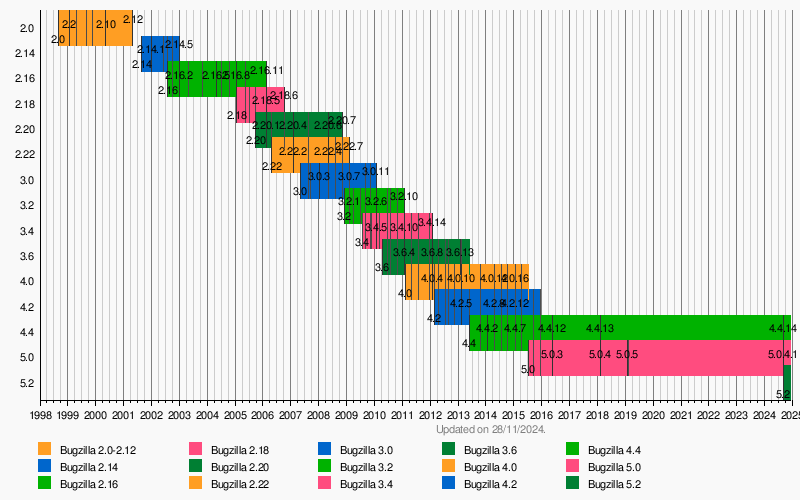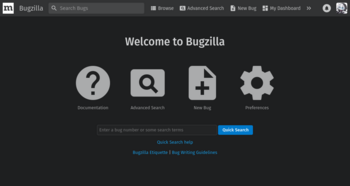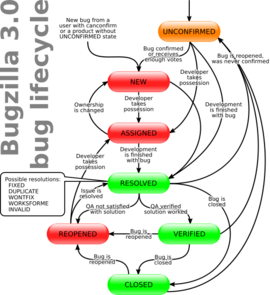Bugzilla facts for kids
Buggie, the mascot of Bugzilla
|
|
| Original author(s) | Terry Weissman |
|---|---|
| Developer(s) | Mozilla Foundation |
| Initial release | August 26, 1998 |
| Stable release | |
| Preview release | 5.1.2 (February 16, 2018 ) |
| Written in | Perl |
| Operating system | Cross-platform |
| Available in | Multiple languages |
| Type | Bug tracking system |
| License | Mozilla Public License |
Bugzilla is a free, web-based tool that helps computer programmers find and fix mistakes in software. These mistakes are often called "bugs." It was first created for the Mozilla project, which is famous for making the Firefox web browser.
Bugzilla was released as open-source software in 1998. This means anyone can use, study, and change its code for free. Because of this, many big organizations use Bugzilla to keep track of bugs in their own software. Some famous users include the teams behind Linux, KDE, Apache, and LibreOffice.
Contents
History of Bugzilla
Bugzilla was created in 1998 by a programmer named Terry Weissman. He made it for the Mozilla.org project to replace an older system used at his company, Netscape Communications.
Originally, Bugzilla was written in a programming language called Tcl. However, Weissman decided to switch it to Perl before releasing it to the public. He hoped that more people would be able to help improve Bugzilla because Perl was a more popular language at the time.
A Community Project
In 2000, Weissman passed control of the project to Tara Hernandez. She encouraged other programmers to get more involved, and Bugzilla's development became a team effort. A year later, Dave Miller took over and continued to lead the project for many years.
Over time, new versions of Bugzilla were released with major improvements:
- Bugzilla 3.0 (2007) got a fresh new look and made it easier to add custom features.
- Bugzilla 4.0 (2011) and Bugzilla 5.0 (2015) continued to add more modern features and improvements.
Timeline of Releases
This timeline shows all the different versions of Bugzilla that have been released over the years.

How Bugzilla Works
The main goal of Bugzilla is to track software bugs. While it could be used for other things, like managing tasks or projects, its creators have decided to keep it focused on finding and fixing errors in code.
When a bug is found, it is entered into the system. From there, programmers can see the bug, discuss how to fix it, and update its status as they work on it. The picture on the right shows the typical journey of a bug from being reported to being fixed.
What Do You Need to Run Bugzilla?
To set up Bugzilla on a server, a few key things are needed:
- A database program like MySQL or PostgreSQL to store all the bug information.
- The Perl programming language.
- A web server to make the Bugzilla website available online.
- A mail server to send email notifications about bug updates.
The installation process is done using a command line interface, which checks to make sure the server has all the necessary software.
Fun Facts About Bugzilla
What are Zarro Boogs?
When you search for bugs in Bugzilla and there are no results, it doesn't say "0 bugs found." Instead, it says "zarro boogs found." This is a funny, intentional misspelling of "zero bugs."
The creator, Terry Weissman, explained that this started with a T-shirt. When Netscape released version 4.0 of its web browser, they had a party and gave out T-shirts that said "Netscape 4.0: Zarro Boogs." The joke was that just like the software probably still had hidden bugs, the T-shirt also had a "bug" (the misspelling).
The message is a friendly reminder that even if you can't find any bugs, it doesn't mean they don't exist. There might be some that just haven't been reported yet!
What Does WONTFIX Mean?
Sometimes, a bug in Bugzilla will be marked as WONTFIX. This label means that even though the bug is real, the programmers have decided not to fix it.
There are several reasons this might happen. The bug might be very minor, or fixing it could be too expensive, difficult, or risky. It might even cause other, more serious problems in the software.
Fun Facts About Bugzilla
Zarro Boogs Found
When you search for bugs in Bugzilla and there are no results, it doesn't say "0 bugs found." Instead, it shows the message "zarro boogs found."
This is a little joke. "Zarro boogs" is a funny spelling of "zero bugs." It's a reminder that even if you can't find any bugs, it doesn't mean there are none. New bugs might just be waiting to be discovered!
The creator, Terry Weissman, explained that this came from a T-shirt made for the release of Netscape 4.0. The shirt said "Netscape 4.0: Zarro Boogs," as a joke that the software had no known bugs.
WONTFIX
Sometimes, a bug report in Bugzilla will be marked as WONTFIX. This label means that the developers have decided not to fix the bug.
There can be several reasons for this. For example, fixing the bug might be too expensive, too difficult, or it could risk creating new, worse problems in the software.
See also
 In Spanish: Bugzilla para niños
In Spanish: Bugzilla para niños
- Comparison of issue-tracking systems
- List of computing mascots
- Category:Computing mascots



